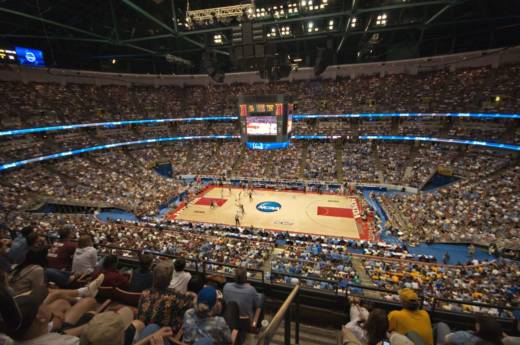And that, of course, means there's also a huge amount of money being made. But the players at the center of it all, banging it out on the court, don't get a dime of it.
College athletes are considered "amateurs" by the NCAA. That means they're prohibited from collecting any kind of monetary compensation (including sponsorship money), even though the tournament they play in has become big business, generating multi-million dollar profits for the NCAA and many of the coaches and schools involved.
As profits grow each year, a growing contingent of former players and advocates are calling on the NCAA to start allowing student athletes earn their fair share. The league, they say, is exploiting students by profiting from their skill and celebrity status without providing appropriate compensation.
Meanwhile, many big-name schools provide few guarantees for student athletes, many of whom practice upwards of 60 hours a week and risk losing scholarships if they get injured and can't play.
A 2015 survey found that just over 1 percent of all men's college basketball players actually get drafted by the NBA, even though about three-quarters of Division I players said they believed playing professionally was at least “somewhat likely."
But the NCAA remains adamant in its stance against student athletes receiving direct financial compensation, insisting that paying players would corrupt the very spirit and nature of intercollegiate sports. The organization emphasizes that the robust scholarships most top student athletes receive, that typically cover tuition and some living expenses, provide access to a top-notch education at some of the best schools in the country, not to mention the opportunity to play on nationally-recognized teams.
Additionally, the NCAA notes that profits from men's basketball and football -- the big intercollegiate revenue generators -- help fund less lucrative sports (because someone's gotta pay for the squash team, right?).
The situation, however, almost changed dramatically in 2014, when a federal judge ruled that the NCAA’s policy of barring payment to college athletes violated antitrust laws. Former UCLA basketball star Ed O’Bannon, now a car salesman in Las Vegas, was the lead plaintiff in the class-action lawsuit. Years after graduating, he discovered that his avatar had been included in a popular college basketball video game, which he had never consented to, and for which he received no royalties.
The judge ruled that athletes in top men’s football and basketball programs should be allowed to receive at least $5,000 per year in licensing revenues (essentially, back-pay), which they could collect at the end of their college sports careers.
The NCAA appealed the decision to the 9th U.S. Circuit Court of Appeals, which agreed that the amateurism rules did violate antitrust laws. But in its ruling, the court fell short of requiring schools to compensate student athletes beyond paying the cost of attendance.
By the numbers:
$0
Amount of compensation college players are allowed to receive (excluding the value of academic scholarships).
$24.2 million
Profits made in 2014 by the Louisville Cardinals, NCAA basketball's top-earning team for that year. The team that year generated about $40 million in revenue. The University of Arizona Wildcats ranked second most profitable, with $17.7 million in earnings (based on $27.5 million in revenue). However, about a third of the 68 teams in men's tournament said they made no profit, including five in 2015 that actually reported losses.
Source: ESPN analysis of U.S. Department of Ed Equity in Athletics data
$10.8 billion
Amount CBS and Turner Sports paid the NCAA for the rights to broadcast the March Madness tournament for a 14-year period ending in 2024.
Source: NCAA
$9.6 million
Salary of Duke Blue Devils head coach Mike Kryzyzewski in 2014 (it's gone down since then). That year, he was NCAA's top-earning basketball coach and one of roughly 35 coaches who make over a $1 million a year.
Source: USA Today
$1.24 billion
Estimated TV ad spending during the 2016 March Madness tournament, a record-setting amount. That makes the tournament one of the most valuable franchises in televised sports, second only to NFL as the most lucrative post-season playoff franchise.
Source: Kantar Media
$10.4 billion
The American Gaming Association's estimate of the amount that will be wagered on the tournament in 2017, including cash from the estimated 70 million office brackets.
Source: American Gaming Association
1.2
The percentage of of men's Division I basketball players who make it to the NBA, a sharp contrast from the roughly 75 percent who say they expect to play professionally.
Source: Inside Higher Ed
For more on the issue, check out the PBS Frontline's 2011 investigation, "Money and March Madness."
